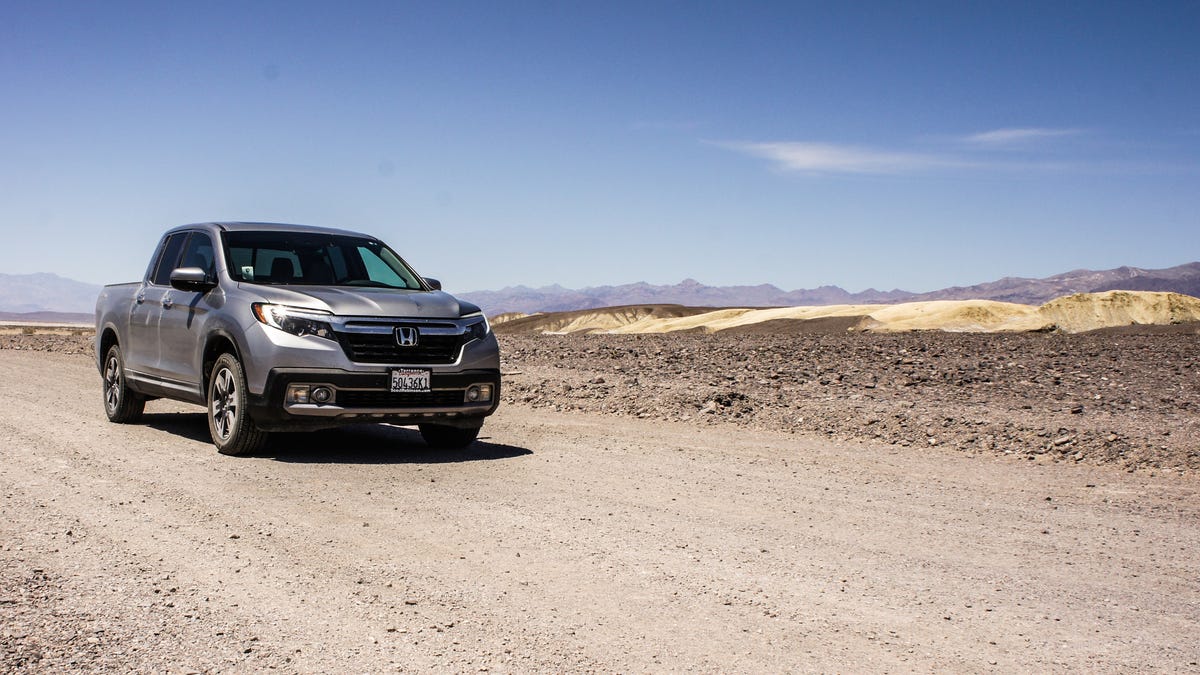Taking the Honda Ridgeline 282 feet below sea level
The lowest and hottest place in the US, Death Valley makes a perfect location to put our Honda Ridgeline pickup truck through some unique challenges while taking in amazing terrain.

When I took the turn off the pavement and onto the washboard dirt road, four offroaders that looked a little more serious than the 2017 Honda Ridgeline I drove sat off to the side, their drivers patiently airing down the tires. "What am I getting myself into?" I thought.
A small sign at the beginning of the road said Racetrack, but I knew that, instead of a paved road course or oval, what waited at the end was one of Death Valley's more bizarre sights: a dry lake bed populated by boulders that apparently move of their own accord, as evidenced by the gouge marks they leave in the dirt.
I chose to drive on by that serious offroader quartet with the Ridgeline's tires at street pressure, and I don't think airing down would have helped much on the ensuing 26 miles of washboard. Traction wasn't an issue, nor was sinking into the soft stuff. No, what this road had to offer was an hour and half of rattling, shuddering and shimmying truck, a long and uncomfortable ride.
Here the Honda Ridgeline sits next to the Racetrack, a dry lake bed, and beyond the rocky outcrop of the Grandstand.
I seriously feared for the Ridgeline's tires and suspension as the road seemed to go on and on, but this 52-mile round trip didn't damage a thing. And the point of the trip, the Racetrack, proved as amazing as I'd heard. Positioned in a basin, the desert landscape suddenly drops a foot or two into a dry lake bed where no plants grow. In the middle sits a rocky island dubbed the Grandstand. And placed haphazardly on the lake bed, big rocks trailing furrows, created by the impulsive action of ice and wind moving the rocks.
I took the Honda Ridgeline, one of Roadshow's long-term test vehicles, on this trip to Death Valley in large part to exercise my film photography hobby. Due to circumstances, I wasn't able to go earlier in the year, and as I pretty much melt in the heat, I figured this weekend at the end of April would be my last chance to make the trip before the summer.
The trip to Death Valley from San Francisco covered about 500 miles, mostly freeway, and made easier by the Ridgeline's adaptive cruise control. However, when traffic slowed, the system's following distance left too much space for other cars to cut in, so I tended to cancel it until I got past any obstructions.
At Father Crowley Overlook, overlooking Panamint Valley, adjacent to Death Valley.
With the Ridgeline's rear folding seats, I made room in the crew cab for myself, two companions and luggage. After a day, empty water bottles and a garbage bag began to encroach on the space, so a cleaning was due, coinciding with frequent uses of a squeegee on the windshield to remove bug spatter.
Based out of Lone Pine, the nearest town where I could find a hotel, the trek into Death Valley each day involved more than an hour's drive over two sets of hills. The Ridgeline required some deep throttle action to get it up the ascents, but proved comfortable on the ensuing curvy downhill runs, letting me maintain good speed through the turns.
Much of Death Valley's major sights feature well-paved roads, so driving to the Devil's Golf Course made for an easy run. Stepping out of the cab, however, to see this weird field of salt formations made it clear that the Ridgeline's air conditioning worked well. With the car set at 70 degrees, I wasn't quite ready for the wall of 95 degree heat. Lucky for me it was still spring, as a few months after this trip temperatures would average 110 degrees.
This odd-looking terrain next to the Ridgeline is made up of salt formations, a nearly impassable field stretching across the valley floor.
Despite the heat, the salt formations are quite a sight, like nothing I've encountered before, and stretching across this wide valley. Given the difficulty of crossing the Devil's Golf Course on foot, and the impossibility of bringing a horse or vehicle across it, much of it is likely untouched by man.
From the Devil's Golf Course, it's only a few miles to Badwater Basin, where the land drops to 282 feet below sea level, the lowest spot of land in the US. The temperature remained hot, and frequent excursions out of the Ridgeline made me wish that it had cooling seats, rather than just its heated ones. But the truck ran without complaint, the engine temp gauge never moving from its neutral position.
Death Valley marks the lowest spot with a sign post, and also labels sea level on a nearby cliff, as a visual reference. It's an impressive sight, as is the odd pool of standing water here and the immense salt flats that stretch out across the plain.
People hang tea kettles at the sign marking Teakettle Junction, 20 miles down the washboard road leading to the Racetrack.
Over the course of this expedition, I drove the Ridgeline more than 1,300 miles and had to feed it over 70 gallons of gas. That comes out to a little better than 18 mpg, with that rough road out to the Racetrack taking a big toll.
Dusty but otherwise none the worse, the Ridgeline is back in our garage, ready for more work.

